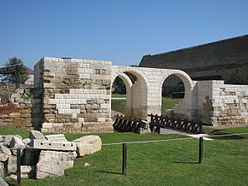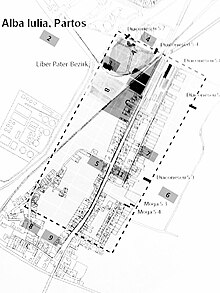Apulum (castra)
Jump to navigation
Jump to search
| Apulum | |
|---|---|
 Porta Principalis Dextra | |
| Alternative name(s) | Apula,[1] Apulon[1] |
| Known also as | Castra of Alba Iulia |
| Founded during the reign of | Trajan |
| Founded | 107 – 108[2] |
| Abandoned | 4th century AD |
| Attested by | Tabula Peutingeriana |
| Place in the Roman world | |
| Province | Dacia |
| Administrative unit | Dacia Apulensis |
| Administrative unit | Dacia Superior |
| Directly connected to | |
| Structure | |
| — Stone structure — | |
| Size and area | 440 m × 430 m (18.9[2] ha) |
| Stationed military units | |
| — Legions — | |
| XIII Gemina,[3] I Adiutrix[4][5] | |
| Location | |
| Coordinates | 46°02′50″N 23°34′0″E / 46.04722°N 23.56667°E |
| Altitude | 245 m |
| Town | Alba Iulia |
| County | Alba |
| Country | |
| Reference | |
| RO-LMI | AB-I-m-A-00001.01[3] |
| RO-RAN | 1026.01[6] |
| Site notes | |
| Recognition | |
| Condition | Ruined |
Apulum was a legionary fortress in the Roman province of Dacia from the 2nd to 4th centuries AD, located in today's Alba Iulia, Romania.[6]
It is the largest castrum in Romania, occupying 37.5 hectares (93 acres) (750 x 500 m). It was the base of the legion Legio XIII Gemina transferred there by Trajan to the newly conquered province of Dacia at the end of the war in 106. In the era of Hadrian (117-138 AD) and of Antoninus Pius (138-161 AD) it was rebuilt in stone.
The city of Apulum grew up around the fortress, eventually becoming the capital of Roman Dacia.
The legion was relocated in 271 to Dacia Aureliana when the northern Dacia province was evacuated
Wikimedia Commons has media related to Castra Apulum.

The types of coins discovered
| Issuer | Issue Date | Type |
|---|---|---|
| Antoninus Pius | 139 | sestertius[7] |
| Julia Maesa | 218–224 | denarius[7] |
| Elagabalus | 222 | denarius[7] |
| Severus Alexander | 223–225 | denarius[7] |
| Sallustia Orbiana | 225–227 | denarius[7] |
| Gordian III | 241–243 | denarius[7] |
| Philip the Arab | 244–247 | antoninianus[7] |
| Cornelia Salonina | 257–258 | antoninianus[7] |
See also
Notes
- ^ a b Schütte, Gudmund (1917). "Ptolemy's maps of northern Europe, a reconstruction of the prototypes". The Royal Danish Geographical Society. Retrieved 2013-05-04.
- ^ a b Domșa, Ovidiu (2009). "Virtual reconstruction of Roman military Apulum camp" (PDF). p. 6. Retrieved February 14, 2013.
- ^ a b "Lista Monumentelor Istorice 2010 ("2010 List of Historic Monuments")" (PDF). Monitorul Oficial al României, Partea I, Nr. 670 ("Romania's Official Journal, Part I, Nr. 670"), page 3. Ministerul Culturii şi Patrimoniului Naţional. 1 October 2010. Archived from the original (PDF) on 2012-06-10. Retrieved 2012-12-30.
- ^ Constantin C. Petolescu: Dacia – Un mileniu de istorie, Ed. Academiei Române, 2010, ISBN 978-973-27-1999-2
- ^ Academia Română: Istoria Românilor, Vol. 2, Daco-romani, romanici, alogeni, 2nd. Ed., București 2010, ISBN 978-973-45-0610-1
- ^ a b "1026.01". National Archaeological Record of Romania (RAN). ran.cimec.ro. 2010-10-22. Archived from the original on 2013-12-19. Retrieved 2012-12-30.
- ^ a b c d e f g h "Apulum Archaeology". Retrieved 2013-05-02.
External links
Categories:
- Pages using gadget WikiMiniAtlas
- Articles with short description
- Short description is different from Wikidata
- Coordinates on Wikidata
- Commons category link from Wikidata
- Webarchive template archiveis links
- Alba Iulia
- Roman legionary fortresses in Romania
- Ancient history of Transylvania
- Historic monuments in Alba County
- Roman legionary fortresses in Dacia
- All stub articles
- Dacia stubs


